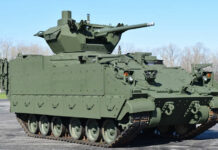Several new systems, recently developed in Israel, reflect a potential change and could lead to re-allocation of responsibilities between the Israel Air Force (IAF) and Land Forces. Since the 1950s, the IAF was exclusively responsible for air supremacy and attack operations deep inside enemy area. The remaining assets were devoted to the ground attack and close air support, assisting ground operations. Since the 1980s, the IAF assumed additional responsibilities, for strike operations at very long range (attacking the Iraqi nuclear reactor was one such example). Within this wide scope of mission tasking, sharing some of the shorter range tactical operation missions with ground elements could free air assets to focus more on strategic long-distance missions.
IAI/MLM entry to the long range artillery market is backed by the extensive know-how gained from other aerospace and defense programs, where technologies required for such precision attack systems were matured, including guidance and navigation systems, based on unique and advanced algorithms, enabling the delivery of a missile to an accurate impact point.
These characteristics transform artillery capabilities, beyond the feasibility of current systems. In the past, artillery relied on unadjusted ballistic trajectory and was considered inaccurate due to the “statistical error”, increasing with the range. The new systems, which include surface attack missiles, guided rockets, and trajectory correction systems are demonstrating high accuracy levels at ranges beyond 100 km. For example, the LORA rocket, developed by IAI/MLM has already demonstrated that warheads can be delivered accurately, within less than 10 meters CEP from a designated target, regardless of the range. The missile’s range and warhead’s weight are limited in order to meet MTCR restrictions and criteria. Other systems, some of which are highlighted in the Israeli industries’ displays at Eurosatory 2006 are outlined below:
In the modern warfare, land, naval and air arms are becoming more integrated, as they gear into “joint” operations, each arm contributing its most suitable and available capabilities in achieving the required effect. Traditionally, airpower was responsible for rapid deployment, naval forces, tasked with force projection and land forces, to fight on the ground, in a specific theater of operations. Ground forces are usually relying on air support to cover activities in deep operations, beyond the range of the current artillery. New systems, including short range missiles, extended range rockets and ground launched precision attack missiles will extend the reach and coverage of the division and corps battle, far beyond their current capabilities. As these extended range weapons mature into fully operational systems, they will require near-real-time intelligence and precise targeting, far beyond the level available today at corps and division level.



















